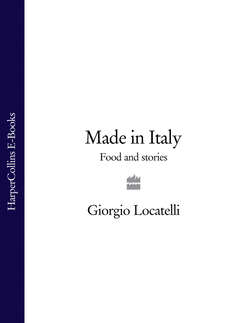Читать книгу Made in Italy: Food and Stories - Giorgio Locatelli - Страница 48
Mozzarella and Burrata ‘Pearly-white treasure’
ОглавлениеIn the UK, people seem to be convinced that mozzarella is something rubbery and bland, after years of having only a version of this cheese that was made of cow’s milk (Fior di Latte), sold in packets and looked like ping pong balls. This is the mozzarella that you could buy in every supermarket twenty years ago, when every neighbourhood Italian restaurant had salad caprese on the menu: mozzarella and tomatoes, sometimes turned into a tricolore with slices of avocado.
Real, fresh, hand-made unpasteurised mozzarella, made from pure buffalo milk in Campania, close to Napoli, is a beautiful pearly-white treasure that keeps for only a few days – something sensual and soft, full of the sweaty, mossy flavours of the buffalo milk. When you have a large ball of this mozzarella, which drips with buffalo buttermilk when you cut into it, you don’t want to do anything other than drizzle over some peppery olive oil, grind over some black pepper and serve it as a starter, just as it is.
To make the cheese, whole fresh buffalo milk is inoculated with a ‘starter culture’ of whey from the previous day’s cheese making, which is left to sour naturally. This is mixed with calf’s rennet and, after about half an hour, it coagulates into soft curds, which are broken up into pieces and left to ripen in warm whey for four or five hours, until the curd becomes stretchy. Then the curds are put into wooden vats of boiling water and stretched by drawing them out continuously with a wooden stick. Finally the mozzatore, the cheese maker in charge of the final stages of the process, judges just the right moment for the hot elastic cheese to be cut into pieces (the name mozzarella comes from the Italian mozzare, ‘to cut’). Then it is gently shaped into large balls, trecce (plaits) or bocconcini (tiny balls weighing just 40-50g) and dipped into a brine bath to let the cheese relax and soften.
Like so many Italian specialities, buffalo mozzarella started off as a poor man’s food, made from the buffalo that were brought into Italy through trade with India and used as beasts of burden, grazing on the marshes of Campania. You had to milk the animals, so people made the milk into cheese. Now, of course, the whole world wants to eat mozzarella. But how many buffalo do people think we have in Italy? Where are they all? Do you get off the plane in Napoli and say to the kids, ‘Look at all the buffalo’?
The reality is that there are only about 600,000 buffalo in Italy and each one will give you around 4-6 litres of milk a day, enough to make about twenty mozzarella. You would need about a million buffalo just to satisfy the demand from the UK alone, so a lot of the cheese has to be made with cow’s milk, or a mixture of buffalo and cow’s milk. If you buy cheese labelled buffalo mozzarella, or mozzarella tradizionale, it might be made either with buffalo milk or a mixture of buffalo and cow’s milk – and there is as yet no law that says the producer must tell you which.
So the way to be sure that the mozzarella you buy is made with 100 per cent buffalo milk is to look for one that carries the mark of the DOP (protected designation of origin) and is labelled mozzarella di bufala Campana. This tells you that the cheese has been made by one of the consorzio of producers within a specific area with unique microclimatic conditions, who have to make their cheese according to very strict laws.
Confusingly, there is another label, mozzarella di latte di bufala (which must also carry the name or registered trademark of the producer between the words mozzarella and di latte). This means that the mozzarella must be 100 per cent buffalo milk. However, it can be made anywhere in Italy and, of course, true aficionados of mozzarella di bufala Campana will say its unique taste is all to do with the particular quality and characteristics of the terrain where the buffalo graze.
Because real, traditionally made unpasteurised buffalo mozzarella is at its best only for a day or so, if we want to buy it in London the producer has to drive it to the airport just hours after it has been made, put it on a plane overnight, then have it collected and sent out to customers in the morning. So, of course, it is expensive and not always easy to find. However, there is another version allowed under DOP rules, which says that the whey in which the mozzarella is kept (in little packets or pots) can be pasteurised, so that the cheese will last longer. This is the one you are most likely to find in delicatessens, and at least you know it has been made traditionally in Campania, from pure buffalo milk.
